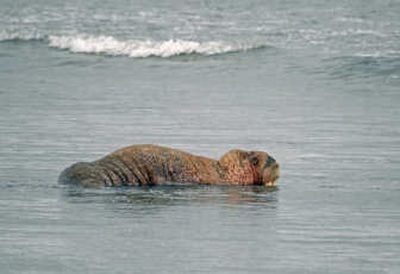Lack of sea ice causes deadly walrus stampede

ANCHORAGE, Alaska – In what some scientists see as another alarming consequence of global warming, thousands of Pacific walruses above the Arctic Circle were killed in stampedes earlier this year after the disappearance of sea ice caused them to crowd onto the shoreline in extraordinary numbers.
The deaths took place during late summer and fall on the Russian side of the Bering Strait.
“It was a pretty sobering year – tough on walruses,” said Joel Garlach-Miller, a walrus expert for the U.S. Fish and Wildlife Service.
Unlike seals, walruses cannot swim indefinitely. The giant, tusked mammals typically clamber onto sea ice to rest, or haul themselves onto land for just a few weeks at a time.
But ice disappeared in the Chukchi Sea this year because of warm summer weather, ocean currents and persistent eastern winds, Garlach-Miller said.
As a result, walruses came ashore earlier and stayed longer, congregating in extremely high numbers, with herds as big as 40,000 at Point Shmidt, a spot that had not been used by walruses as a “haulout” for a century, scientists said.
Walruses are vulnerable to stampedes when they gather in such large numbers. The appearance of a polar bear, a hunter or a low-flying airplane can send them rushing to the water.
Sure enough, scientists received reports of hundreds of walruses dead of internal injuries suffered in stampedes. Many of the youngest and weakest animals, mostly calves born in the spring, were crushed.
Biologist Anatoly Kochnev of Russia’s Pacific Institute of Fisheries and Oceanography estimated 3,000 to 4,000 walruses out of a population of perhaps 200,000 died, or two or three times the usual number, on shoreline haulouts.
He said the animals only started appearing on shore for extended periods in the late 1990s, after the sea ice receded.
“The reason is the global warming,” Kochnev said.
The reports match predictions of what might happen to walruses if the ice receded, said wildlife biologist Tony Fischbach of the U.S. Geological Survey.
“We were surprised that this was happening so soon, and we were surprised at the magnitude of the report,” he said.